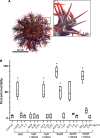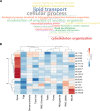Crown-of-thorns starfish spines secrete defence proteins
- PMID: 37637177
- PMCID: PMC10448888
- DOI: 10.7717/peerj.15689
Crown-of-thorns starfish spines secrete defence proteins
Abstract
Background: The crown-of-thorns starfish (COTS; Acanthaster species) is a slow-moving corallivore protected by an extensive array of long, sharp toxic spines. Envenomation can result in nausea, numbness, vomiting, joint aches and sometimes paralysis. Small molecule saponins and the plancitoxin proteins have been implicated in COTS toxicity.
Methods: Brine shrimp lethality assays were used to confirm the secretion of spine toxin biomolecules. Histological analysis, followed by spine-derived proteomics helped to explain the source and identity of proteins, while quantitative RNA-sequencing and phylogeny confirmed target gene expression and relative conservation, respectively.
Results: We demonstrate the lethality of COTS spine secreted biomolecules on brine shrimp, including significant toxicity using aboral spine semi-purifications of >10 kDa (p > 0.05, 9.82 µg/ml), supporting the presence of secreted proteins as toxins. Ultrastructure observations of the COTS aboral spine showed the presence of pores that could facilitate the distribution of secreted proteins. Subsequent purification and mass spectrometry analysis of spine-derived proteins identified numerous secretory proteins, including plancitoxins, as well as those with relatively high gene expression in spines, including phospholipase A2, protease inhibitor 16-like protein, ependymin-related proteins and those uncharacterized. Some secretory proteins (e.g., vitellogenin and deleted in malignant brain tumor protein 1) were not highly expressed in spine tissue, yet the spine may serve as a storage or release site. This study contributes to our understanding of the COTS through functional, ultrastructural and proteomic analysis of aboral spines.
Keywords: Crown-of-thorns starfish; Defence; Echinoderm; Phospholipase A2; Plancitoxin; Spine; Venom.
©2023 Hillberg et al.
Conflict of interest statement
Min Zhao is an Academic Editor for PeerJ.
Figures






References
-
- Alqaisi KM, Lamare MD, Grattan DR, Damsteegt EL, Schneider WJ, Lokman PM. A comparative study of vitellogenesis in Echinodermata: lessons from the sea star. Comparative Biochemistry and Physiology Part A: Molecular & Integrative Physiology. 2016;198:72–86. doi: 10.1016/j.cbpa.2016.04.013. - DOI - PubMed
-
- Birkeland C. The Faustian traits of the crown-of-thorns starfish. American Scientist. 1989;77:154–163.
Publication types
MeSH terms
LinkOut - more resources
Full Text Sources
Research Materials
Miscellaneous

